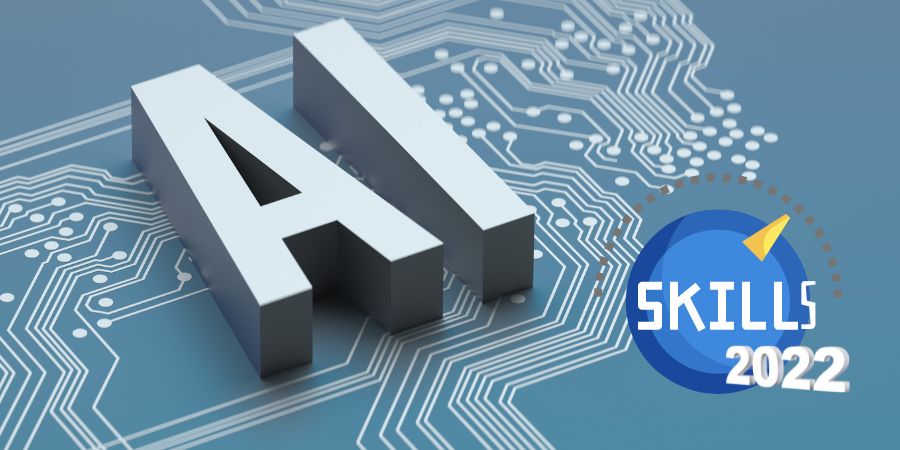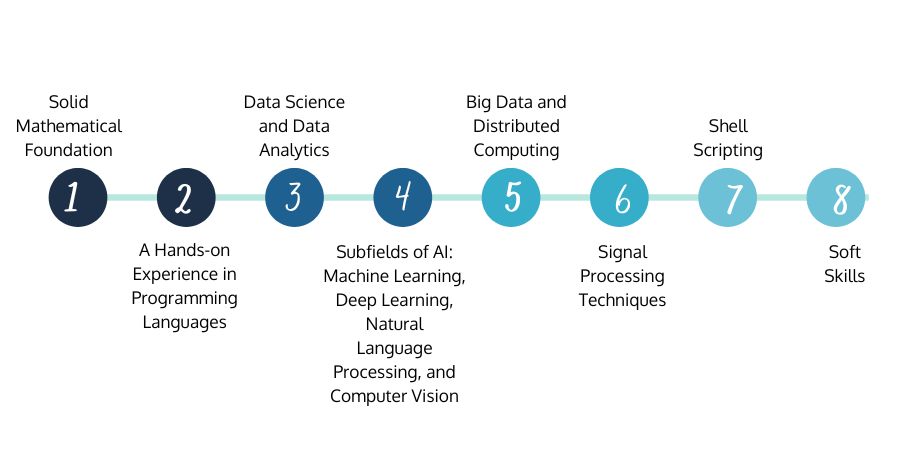
AI has the potential to disrupt every industry, and its widespread acceptance and expected stable growth make it the hottest job, tapping the market. AI demand will likely bring about 97 million jobs between 2022 and 2025.
Businesses realise the efficiency gain that can be achieved via leveraging the power of cutting-edge tech capabilities and the demand for competent people in the tech industry. However, enterprises are still battling to find individuals with the abilities required to design, train, and work with intelligent machines.
This blog enlists the most in-demand valuable skills you must learn today to step into the AI-first world.

1. Solid Mathematical Foundation
The following are some of the mathematical disciplines that help you understand programs (algorithms) and logic:
-
Mathematical skills include linear algebra, statistics, probability, graphs, optimisation methods, etc. These competencies help you to build algorithms as per requirements/ or data specifications.
-
Statistics: Statistics is a subfield of mathematics that deals with data collection, analysis, and interpretation. Statistical understanding enables you to understand the patterns inside the data while spotting outliers.
-
Probability theory: Probability is an essential part of AI and is extensively used for discriminative and generative models, support vector machines, and more.
2. A Hands-on Experience in Programming Languages
AI specialists must be fluent in programming; however, each language has its own advantages and is used for specific purposes.
-
Python: It is syntactically easier than languages such as C++ or Java. It's a high-level, general-purpose, interpreted language. Python aims to make code readable and compact. It offers advanced libraries for sophisticated computation.
-
Java: This emerged from data analysis tools including Spark, Flink, Hive, Spark, and Hadoop. This eases implementing intelligence programming, search algorithms, genetic programming, ML approaches, and neural networks in AI.
-
R: It is a scripting language with dynamic typing and is widely used for statistical computation. R includes many statistical and graphical tools when used for analytical tasks.
-
C++: This programming language is used by AI to expedite procedural programming and hardware resource manipulation. It helps produce browsers, video games, and operating systems due to its versatility and object-oriented qualities.
3. Data Science and Data Analytics
Data science remained a part of computer science school curricula, and in the digital-first world, it emphasises addressing business problems with data. Data is vital to machines' ability to think and learn. It's used to train AI robots/models to perform tasks. Data analytics experts understand collecting, manipulating, and interacting with data to obtain actionable insights. These are demanded abilities in the field of AI.
Data analytics is an essential component of data science. It entails leveraging a large dataset to obtain actionable insights. Data analysts are competent in finding trends, spotting anomalies, and determining correlations between variables, which can help AI systems increase their accuracy.
4. Subfields of AI: Machine Learning, Deep Learning, Natural Language Processing, and Computer Vision
Machine Learning and Deep Learning are two fields of Computer Science; both involve training computers to learn from data without explicit programming. While machine learning is used to increase the accuracy of software predictions, deep knowledge increases the performance of ML systems by supplying more data to systems to learn from.
In recent times, machine learning and deep learning are becoming increasingly crucial through which computers can learn from experience and adapt to new conditions. Deep learning employs neural networks to learn. Neural networks are interconnected networks of processing nodes that recognise patterns in input data.
Natural Language Processing studies how computers interpret and process human language. NLP can be used for various tasks, including machine learning, text summarisation, and automatic translation. It performs activities such as comprehending word meanings, breaking phrases into their constituent pieces and comprehending word relationships.
Computer Vision is the study of how computers perceive and comprehend digital images. It encompasses operations such as facial recognition, detecting items and objects in photographs, and estimating the 3D geometry of objects in images.
5. Big Data and Distributed Computing
Predictive modelling and data analysis in AI entail massive datasets demanding immense computational resources. Implementing a single system to perform large-scale computation may be insufficient to meet the required outcomes. Therefore, technologies such as Big Data and distributed computing are beneficial.
-
Big Data is a technology that extracts, manages, and analyses a pool of data efficiently. This data requires a lot of computation power and provides superior statistical capabilities. Big data is utilised in user behaviour analysis, predictive analytics, and other huge data set analytical purposes.
-
Distributed computing is a discipline of computer science that involves distributed systems whose components are located on many networked computers while coordinating and communicating their operations by sharing messages. Its applications are multiplayer online video games and peer-to-peer software.
6. Signal Processing Techniques
Signal processing is a subfield of electrical engineering that incorporates the study, modification, and synthesis of any type of signal (e.g. audio, radio, image, or any scientific measurements). This technique advances storage efficiency, transmission, and quality while spotting critical components in a signal. This may include time-frequency analysis, convolution, and Fourier Analysis for computer vision algorithms.
Signal processing (specifically the techniques wavelets and contourlets) is widely employed for feature extraction, such as
-
Speech recognition and image comprehension
-
Audio signal processing, such as music or speech representation
-
Image processing in computers and digital cameras
-
Video processing in moving pictures, and wireless communication
-
Source coding techniques include image, video, and audio compression.
7. Shell Scripting
Shell scripting or bash scripting is one of the critical aspects of AI or pattern recognition tasks. A shell script is a program designed to execute by the Unix shell. Shell scripts can perform common processes such as file manipulation, printing text, and program execution.
There are numerous types of shells, including KornShell (ksh), Almquist shell (ash), Powershell (msh), Z shell (zsh), Tenex C Shell (tcsh), and Perl-like shell (psh). As Linux-based machines are used in businesses, understanding shell scripting and familiarity with commands such as awk, grep, ssh, and more are essential.
8. Soft Skills
It's substantial to employ computers to make informed decisions while gaining a more profound knowledge of complex subjects than based on human-scale analytics. Many enterprises have demonstrated that they can bring about large-scale, positive change using AI and machine-driven decision-making. Communication skills, creativity, and decision-making are essential soft skills for achieving potential benefits.
Data communicators and interpreters are among the most in-demand skill sets in business regarding AI/ML. Furthermore, strong visualisation skills are another necessity to transform data insights into captivating storytelling that communicates precisely what needs to be done and how to achieve development and results.

 Batoi Corporate Office
Batoi Corporate Office